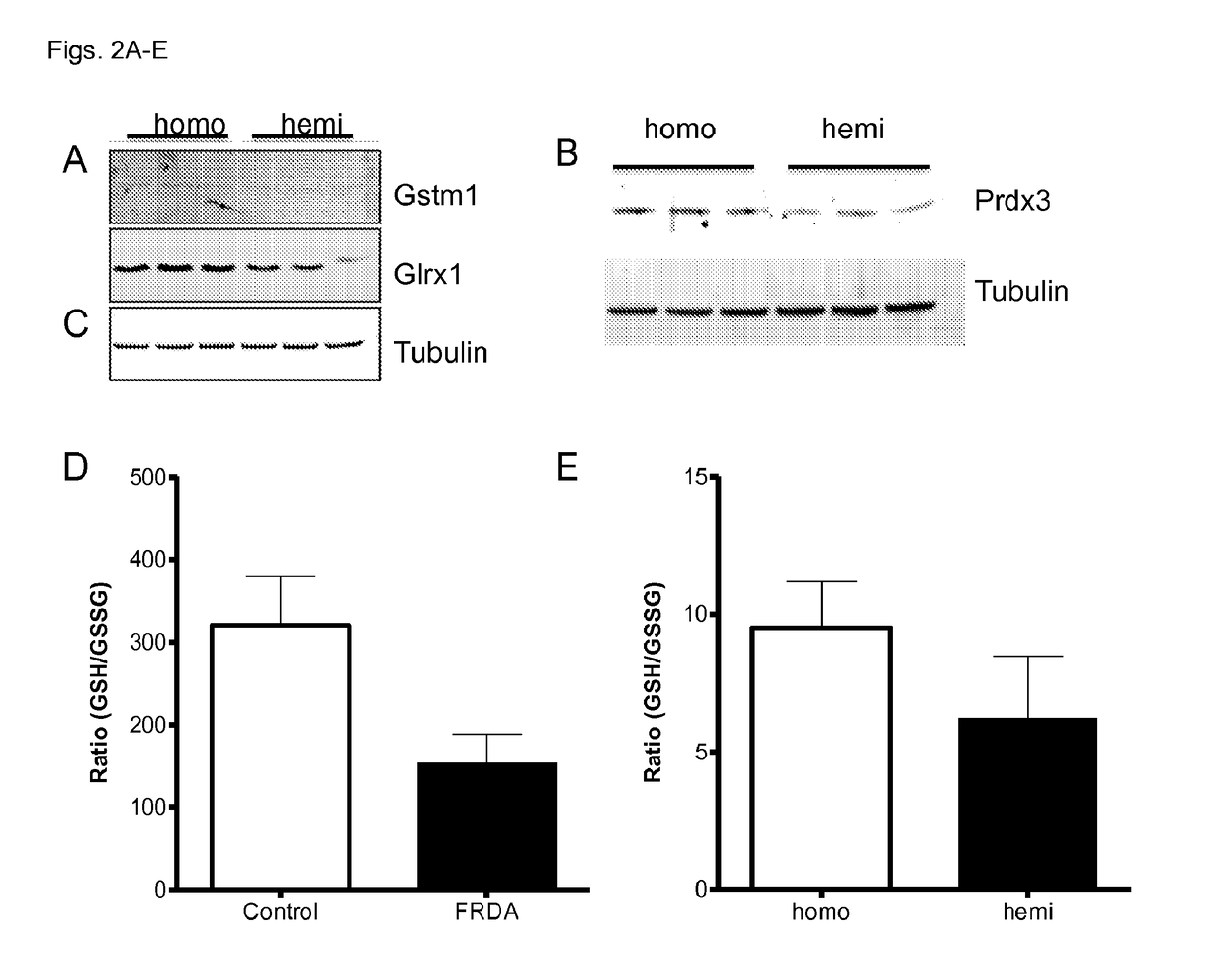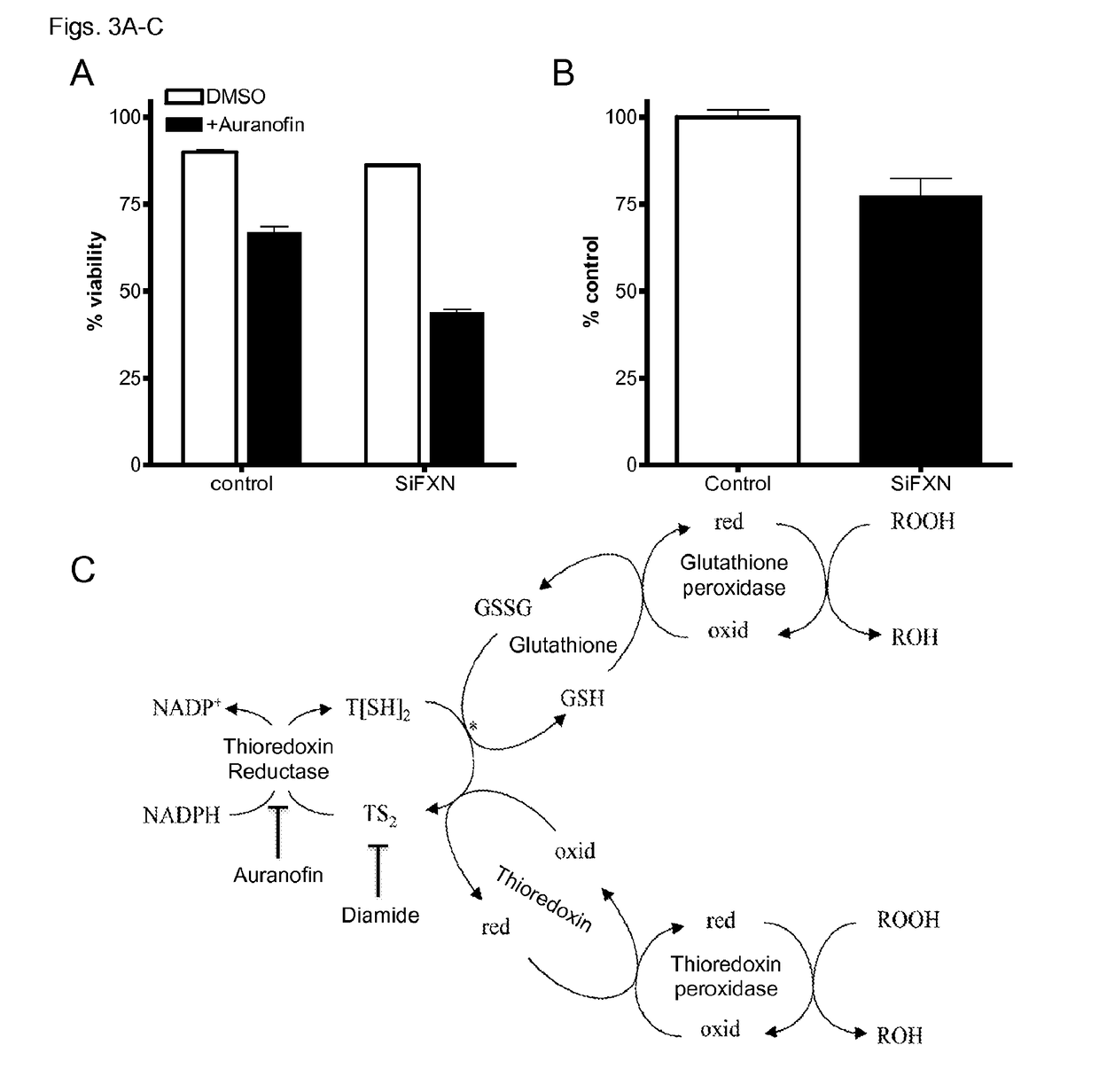Agents useful for treating friedreich's ataxia and other neurodegenerative diseases
a neurodegenerative disease and agent technology, applied in the field of agents useful for treating friedreich's ataxia and other neurodegenerative diseases, can solve the problems of not being approved for friedreich's ataxia therapy, and achieve the effects of fewer side effects, favorable response and improved efficacy
- Summary
- Abstract
- Description
- Claims
- Application Information
AI Technical Summary
Benefits of technology
Problems solved by technology
Method used
Image
Examples
example 1
[0166]Mechanism of Pathophysiology of Friedreich's Ataxia and Rescue with Biochemical Agents.
[0167]FIG. 1 (top panel) illustrates a pathophysiological model for Friedreich's ataxia based on dorsal root ganglion microarrays and biochemical investigation and drug screening. Frataxin is involved in mitochondrial iron-sulfur cluster biogenesis, and facilitates mitochondrial selenocysteine metabolism, which is essential to the protection of mitochondria from oxidative stress, which is primarily mediated by the selenoenzymes Thioredoxin reductase (Txrd2), and glutathione peroxidase (GPX5). As a result of deficiency of frataxin, these selenoenzymes have decreased activity, and Nrf2 declines, the result is decreased mitochondrial antioxidant protection, increased aggregates, reactive oxygen species, inflammation and neurodegeneration. In addition frataxin interacts with NFS1 of the 2Fe2S cluster biogenesis machinery, necessary for glutaredoxin 2 and ferredoxin 2 function. Reduced function o...
example 2
[0168]Multiple proteins directly or indirectly reduced by thioredoxin reductase are deficient in YG8 mice. DRGs of YG8 mice were microdissected and protein expression of genes measured. Peroxiredoxin-3, Glutaredoxin-1 and Glutathione-S-transferase-1 were each decreased (FIG. 2A-C). Glutathione is the most important redox buffer in the cell and low GSH / GSSG indicates increased oxidative stress. It has been shown that FRDA patient lymphoblasts had decreased GSH / GSSG as a consequence of elevated GSSG levels (Tan, et al., Hum Mol Genet (2003) 12:1699-1711) (FIG. 2D). Similarly, hemizygous YG8 mice cerebellum and DRG tissue had significantly more and about twice the level of GSSG than homozygous mice (0.23 vs. 0.14 micromol / g), causing a decreased GSH / GSSG ratio, demonstrating increased oxidative stress in this tissue (FIG. 2E).
example 3
[0169]Frataxin deficiency causes thioredoxin reductase deficiency, and decreased antioxidant activity and expression. A connection was sought between the multiple thiol-related antioxidants (peroxiredoxins, glutaredoxins, thioredoxins, GSSG) that were decreased in microarray and Westerns of the YG8 DRGs; most of them are reduced by thioredoxin reductase (FIG. 3C). Thioredoxin reductase, in addition to reducing the 2Fe2S-cluster containing glutaredoxin 2, also reduces peroxiredoxins, thioredoxins, and glutathione, which are used as a mitochondrial antioxidant system. Frataxin was knocked down using siRNA in HeLa cells and decreased thioredoxin reductase activity was observed (FIG. 3A). Frataxin deficiency and thioredoxin reductase deficiency additively caused cell death (FIG. 3B).
PUM
| Property | Measurement | Unit |
|---|---|---|
| pKa | aaaaa | aaaaa |
| oxidative stress | aaaaa | aaaaa |
| antioxidant response | aaaaa | aaaaa |
Abstract
Description
Claims
Application Information
 Login to View More
Login to View More - R&D
- Intellectual Property
- Life Sciences
- Materials
- Tech Scout
- Unparalleled Data Quality
- Higher Quality Content
- 60% Fewer Hallucinations
Browse by: Latest US Patents, China's latest patents, Technical Efficacy Thesaurus, Application Domain, Technology Topic, Popular Technical Reports.
© 2025 PatSnap. All rights reserved.Legal|Privacy policy|Modern Slavery Act Transparency Statement|Sitemap|About US| Contact US: help@patsnap.com



